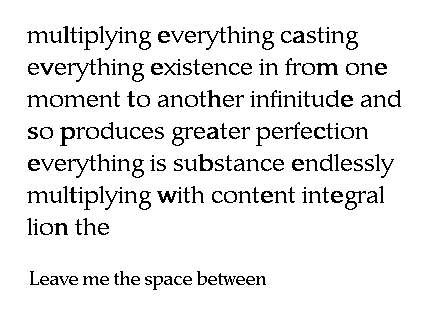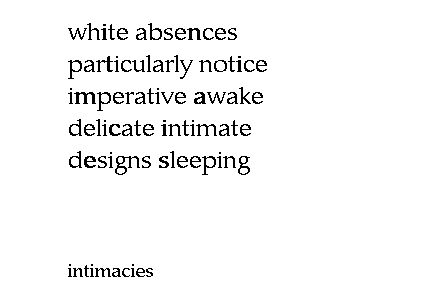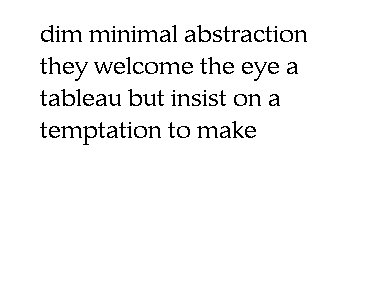CATALOGUE
|
IN # |
|
|
IX |
Oisleand |
|
VIII |
<Reveal> |
|
VII |
Clock |
|
VI |
Book Unbound |
|
V |
Leaving City |
|
IV |
Golden Lion |
|
III |
Moods & |
|
II |
Collocations |
|
I |
IN 1.2 |
PROGRAMMATOLOGY
| Introduction
| RL Installation
| Codexspace
| Publications
| Writer
| Precedents
THEORY / PRACTICE
| Of Programmatology
| Overview
| Why?
| Transliteration
| Hyper-/Cyber-/Poetext
WEB WORKS &
SAMPLES
| OISLEÁND
| generated texts:
: First Lesson
: Actual Possession
of the World
: Leaves
from Book Unbound
DOWNLOAD
IN CV
: list of previous talks
: installations &
: performances
: relating to IN
SHADOOF
LINKS
![]()

I N D R A ' S : N E T
: o r :
H O L O G O G R A P H Y
machine modulated poetry | books unbound
(Plastic) Literary Objects | POtential LIterary OUtlawry
C A T A L O G U E
O F : E X I S T I N G : W O R K S
OISLEÁNDIndra's Net IX 'Oisleánd' is an exploration of the translation and transformation of one written language into another. In its cybertextual form (as computer software encoding a literary object - specifically a HyperCard stack and graphics files which you may download as shareware from the Indra's Net Download Point) it uses mesostic techniques to sow the text of either original or translation within the spelt words of the parallel text in its corresponding language. You may explore a set of 'Frozen & Painted Readings' - colour screen shots which capture and make clear the principles involved here on the Web. London: Wellsweep, 1996. ISBN 0 948454 28 8. |
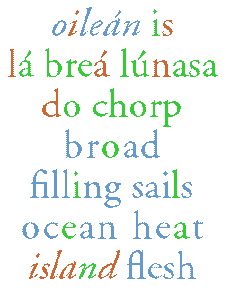 |
Pressing the REVEAL CODE KeyIndra's Net VIII Using a development of the form initiated in Book Unbound, this piece allows readers to create and explore collocational blends generated from an article on the relationship between software engineering and experimental poetics written for the electronic Journal, EJournal ("an all-electronic, e-mail delivered, peer-reviewed, academic periodical" - to subscribe, send 'sub ejrnl' to: listserv@albany.edu; to get vol. 6, no. 1, send 'get ejrnl V6N1' to the same address, or visit the EJournal web site: http://www.hanover.edu/philos/ejournal/home.html). London: Wellsweep, 1995. ISBN 0 948454 27 X.
it can be made to enrich such phenomena real inscriptions of our most intimate activities real inscriptions of our creative and destructive operations so either of these absent agents may be programmers press the reveal code key |
|
THE SPEAKING CLOCK Indra's Net VII ... with acknowledgements to Emmett Williams's 'Poetry Clock' and, more specifically, to John Christie's mechanical 'Word Clocks' ... however this (silent) speaking clock in software both composes from a given text according to quasi-aleatory procedures and actually tells the 'real time': "What if it was impossible to apply a single name from a finite set to a moment which seems to recur in an acknowledged cycle of time? What if it was impossible to apply the word 'dawn' to more than one single instant at the beginning of some one particular day?" -- from the given text. London: Wellsweep, 1995. ISBN 0 948454 26 1. |
|
|
|
|
Book
Unbound was selected for inclusion in: the special Hypertext Issue of pmc. London: Wellsweep & Engaged, May, 1995. ISBN 0 948454 97 0. 'Leaves' from Book Unbound |
| Remarks on 'Book Unbound' from Espen Aarseth's 'Cybertext: Perspectives on Egodic Literature' Baltimore: John Hopkins University Press, 1997, pp. 56-57. <http://www.hf.uib.no/cybertext> "John Cayley's Book Unbound is a literary work not easily classified by traditional aesthetics. As a computer program (written in Hypercard), it takes over the screen and spits forth short suggestive sentences one word at a time ... "The program is assembling these lines from its 'hidden texts' according to certain algorithms. As the process goes on, the hidden text is changed by what is displayed, and the user can select passages for inclusion in the regenerative process. Thus the text output is influenced, and will be different for each copy of the text. Is it still the same text? Cayley calls the produced output 'hologograms,' fragments that contain holographic versions of the initial material.... "This text is an impurity, a site of struggle between medium, sign and operator. The fragments produced are clearly not authored by anyone, they are pulverized and reconnected echoes of meaning, and the meaning that can be made from them is not the meaning that once existed. Book Unbound is an extreme paragon of cyborg aesthetics, an illustration of the issue of communicative control. The pleasure of this text is far from accidental; it belongs not to the illusion of control, but to the suggestive reality of unique and unrepeatable signification. It would be a grave mistake to see this text as a metaphor of the 'impossibility of perfect communication' or as the embodiment of the gap between sign and meaning in texts. Instead, it shows how meaning struggles to produce itself, through the cyborg activity of writing." Aarseth's study is a highly-recommended contribution to the study of cybertextual literature, especially for it's typologies of potential genres (and textual communication generally), its application of sophisticated but down-to-earth literary and theoretical analyses to the entire range of emergent literary forms, including, importantly, the cooperative, cyborg literature of MUDs and MOOs. |
LEAVING THE CITYIndra's Net V Collocational blends of three prose works: a translation and adaptation of Gu Cheng's (1956- 1993) 'Sounds I hear / sounds I make while waiting for death'; a newspaper report of Gu Cheng's murder of his wife and his own subsequent suicide; and reflections by the author on Gu Cheng's violence, 'Mortal sound'. London: Wellsweep, Feb. 1995. ISBN 0 948454 96 2. Actual Possession of the World
... |
An Essay on THE GOLDEN LIONHan-Shan in Indra's Net A mesostic demonstration of 'interpenetration and mutual identification' based on an original poem by the author and Fazang's (643-712) 'Essay on the Golden Lion'. London: Wellsweep, Nov. 1994. ISBN 0 948454 95 4. A limited edition paper version of this piece has been published by The Morning Star Press, Edinburgh:
The cost is GBP£5 / US$10.
|
|
|
MOODS & CONJUNCTIONSIndra's Net III Collocational procedures applied to three related texts, generating a new work which explores strictures and constraints associated with both sex and language. London: Wellsweep, 1993-94. ISBN 0 948454 93 8. First Lesson |
|
|
| Moods & Conjunctions also contains developments of earlier work. This screen shot is taken from its rendition of the piece 'Indra's Net 2'. |
|
COLLOCATIONS Indra's Net II The first demonstration of a collocation hologogram applied to a prose work by the author and concerning the paintings of Zurich-based British artist, Christopher Bledowski. London: Wellsweep, 1993. ISBN 0 948454 87 3. A paper version of Collocations is published by the Many Press, London in an edition of 221, 16-page pamphlets, each of which is unique:
This may also be ordered at GBP£2 / US$4 per copy. |
|
|
| INDRA'S NET I.2 A revision of the original Indra Net essays with the first version of 'Under it All' as centre- piece. Pre-dominantly mesostic (internal-acrostic) pieces, with much explanatory material. London: Wellsweep, 1991-93. ISBN 0 948454 84 9. |
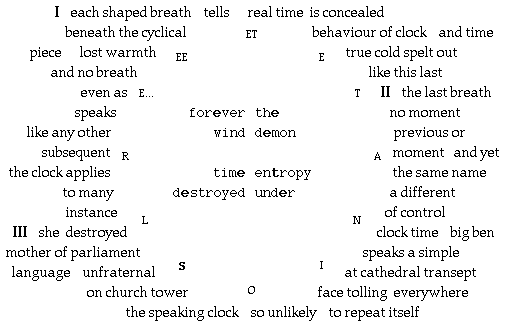
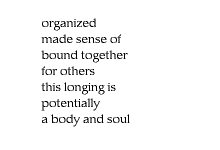 BOOK UNBOUND
BOOK UNBOUND
